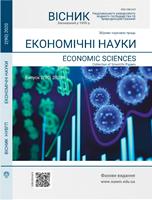RESEARCH METHODOLOGY OF INTELLECTUALIZATION PROCESSES IN MODERN ECONOMY
DOI:
https://doi.org/10.31713/ve2202019Keywords:
research methodology, human capital, intellectual property, institutionalization, basic indicators.Abstract
The methodological bases of intellectual capital research aresubstantiated in the article.It is proposed to consider the methodology of research ofintellectualization processes in modern economy as the process ofintellectual property, as a certain result in terms of the availability ofintellectual resources; human capital, which is fundamental for theformation of innovation and development.The authors conducted a comparative analysis of approaches to theassessment of human capital. Based on the research data, it is determined that among the available approaches that assess human capital today are: cost approach, income approach and indicative approach.The directions of intellectualization in the modern economy aredetermined. The methods used by the World Intellectual PropertyOrganization (WIPO), the Organization for Economic Cooperation andDevelopment (OECD), the World Trade Organization (WTO), the World Bank, and the World Economic Forum are described. Indicators for assessing the effectiveness of the national institutional system for ensuring the quality of education and competitiveness of science using basic indicators as the main source of information are proposed. Therefore, the latest methodologies of intellectualization processes in the modern economy, although they contain a large number of indicators, but they are quite fragmentary.Summarizing the existing methodologies for the study of intellectualization processes in the modern economy, it was proposed to improve approaches to assessing intellectual capital by justifying the limits of application of existing metrics. As part of the systematization of existing scientific studies, existing scientific studies on the methodology of studying the processes of intellectualization in the modern economy should be divided into two major areas of knowledge, these studies relate to the processes of intellectual property capital, which is fundamental for the formation of innovation and development.In such conditions, further substantiation of the methodology ofintellectualization processes in the national economy is of considerablepractical interest.References
Vittadini G., Lovaglio P. G. Evaluation of the Dagum–Slottje method to estimate household human capital (2007). Structural Change and Economic Dynamics. T. 18. № 2. S. 270–278.
Kendrick J. W. Total capital and economic growth (1994). Atlantic Economic Journal. T. 22. № 1. S. 1–18.
Frank A. G. Human capital and economic growth (1960). Economic Development and Cultural Change. T. 8. № 2. S. 170–173.
Kalaitzidakis P. et al. Measures of human capital and nonlinearities in economic growth (2001). Journal of Economic Growth. T. 6. № 3. S. 229–254.
Miller H. P. Lifetime income and economic growth (1965). The American Economic Review. T. 55. № 4. S. 834–844.
Ben-Porath Y. Lifetime Income and Economic Growth: Comment (1966). The American Economic Review. T. 56. № 4. S. 869–872.
Dahan M., Tsiddon D. Demographic transition, income distribution, and economic growth (1998). Journal of Economic growth. T. 3. № 1. S. 29–52.
Jorgenson D. W., Fraumeni B. M. Investment in education and US economic growth (1992). The Scandinavian Journal of Economics. S. 51–70.
Folloni G., Vittadini G. Human capital measurement: a survey (2010). Journal of economic surveys. T. 24. № 2. S. 248–279.
Shih K. H. et al. The indicators of human capital for financial institutions (2010). Expert Systems with Applications. T. 37. № 2. S. 1503–1509.
Nhuan M. T. et al. An indicator-based approach to quantifying the adaptive capacity of urban households: the case of Da Nang city, Central Vietnam (2016). Urban Climate. T. 15. S. 60–69.
Biletskiy O. Indykatyvna monitorynhova otsinka yakosti formuvannia ta vykorystannia liudskoho kapitalu v Ukraini (2016). Ekonomika i orhanizatsiia upravlinnia. № 2 (22). S. 239–246.
Bevz V. P., Buhaenko Ye. O. Pidvyshchennia efektyvnosti vykorystannia liudskoho kapitalu yak vyznachenyi chynnyk ekonomichnoho ta sotsialnoho rozvytku (2012). Formuvannia rynkovykh vidnosyn v Ukraini. № 5. S. 133–139.
Guide on Measuring Human Capital. URL: https://www.unece.org/fileadmin/DAM/stats/documents/ece/ces/bur/2016/February/15-Add1-Human_Capital_Guide_after.pdf. (Accessed: 22.05.2020).
Inside WIPO. URL: https://www.wipo.int/about-wipo/en/ (Accessed: 22.05.2020).
Organisation for Economic Co-operation and Development. URL: https://www.oecd.org/about. (Accessed: 22.05.2020).
World Trade Organization. URL: https://www.wto.org/ (Accessed: 22.05.2020).
Nauenberg E., Basu K., Chand H. Hirschman–Herfindahl index determination under incomplete information (1997). Applied Economics Letters. T. 4. № 10. S. 639–642.
Schmidt A., Walter S. G., Walter A. Radicalness of technological inventions and young venture performance. The role of technological competition and product diversity (2013). IEEE Transactions on Engineering Management. T. 60. № 4. S. 728–738.
Measuring the technological and economic value of patents. URL: https://www.oecd.org/sti/ieconomy/Chapter2-KBC2-IP.pdf (Accessed: 22.05.2020).
United Nations Development Programme. URL: http://hdr.undp.org/en/content/human-development-index-hdi (Accessed: 22.05.2020).

